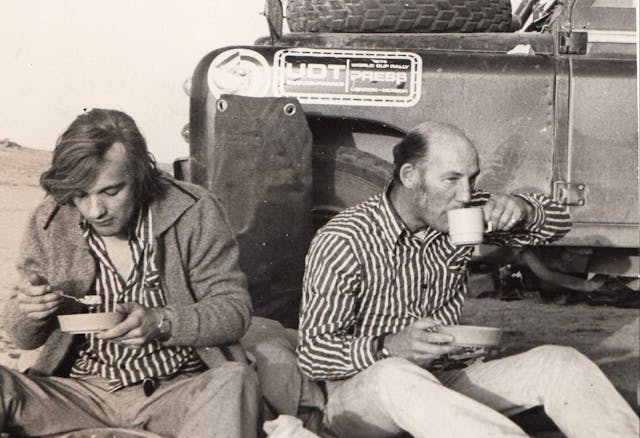Media | Articles
When Stirling Moss cheated death in the Sahara desert
Every racing driver must have given thought to their own mortality, whether on the race track or on a rally in the mountains. Stirling Moss was an exceptional driver and competed in hundreds of events and faced death on numerous occasions. Would he ever have thought it would be death from dehydration when he found himself stranded at an abandoned Foreign Legion fort in the Sahara desert? Never.
But so it was when he and fellow racing driver Michael Taylor and mechanic Allan Sell were taking part in an endurance rally that had taken them from London, across France and Spain to North Africa, in a poorly prepared Mercedes rally car.
From the start they had problems, and by the time they ended their rally Sell was ill, suffering from exhaustion, and Moss and Taylor were having to consider drinking radiator water or take their chances with rank water from an old well they found. As the hours trickled by and the sun beat down, there was plenty of time to consider their predicament in a remote spot in the desolate Sahara. Would what water they had last long enough for them to be found? Was anyone searching for them? How cruel and protracted would death by dehydration be?
It was a long tale that brought Moss to the point where he was staring death in the face. His family was steeped in motorsport—members of Harrow Car Club. Dad raced at Brooklands and Indianapolis, Mum was a top trials driver, whilst sister Pat was a top-level international equestrian before becoming one of the best female rally drivers of her era.
Moss started with rallying at the club level in a Morris Minor and mixed it with his burgeoning racing career, which gradually took most of his time. However, to broaden his experience, in 1950 family friend and racer Lance Macklin took him on the Daily Express Rally in a factory-loaned Aston Martin DB2.
Marketplace
Buy and sell classics with confidence
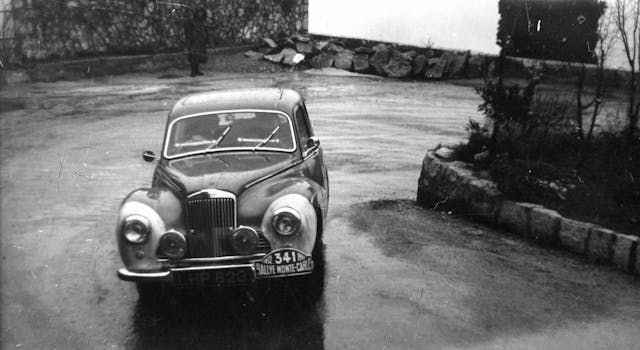
It was the foresight of Norman Garrad, Rootes Competitions Manager, that saw the potential of getting racing star Moss into a rally car by inviting him to lead the company team on the Monte Carlo Rally 1952. His fee was said to be £50.
On the way down from the U.K. to the start in Monaco, Moss, along with his companions John Cooper (Sports Editor, The Autocar) and Dennis Scannell (Secretary, the British Racing Drivers Club), undertook reconnaissance of the route they would be following later. In their Sunbeam Talbot they became stuck in a snowdrift and had to call on a farmer and his oxen to pull them out.
It was snow that probably prevented Moss, Cooper, and Scannell from taking a sensational win, as they slid on ice on the final night of the rally and had to settle for second place. A fine result anyway.
Two more trips on the Monte Carlo Rally for the trio would follow driving Sunbeam Talbots with good results, a sixth and 14th.
Three unpenalized runs of the summer Alpine Rally culminated in a Coupe d’Or, the gold cup, a coveted award—only three were ever given. Again, Moss was driving for Rootes on these rallies, either in Sunbeam Talbots or Alpines.

By now Moss had his own left-hand-drive Jaguar XK120 to use when traveling to races in Europe, and he wasn’t averse to using the car for rallies. During a break testing for BRM at Monza, he entered the Lyon-Charbonnière Rally, another using the best roads of the Alps and the Central Massif—Moss was getting very familiar with all these roads. Gregor Grant, who launched Autosport magazine, went with him, but they finished outside the top 10.
Moss also took the car on another edition of the Daily Express Rally, accompanied by Cooper. Moss’ fame was spreading, and he was frequently being besieged by members of the public seeking autographs. The rally route took in the best rally roads of the Lake District and Wales and finished with autotest-style challenges for the tired cars and drivers on the front at Brighton. They won their class and came 13th overall.
Moss was by now a well-established racing driver and drove a Mercedes Benz 300SLR on the 1000-mile Mille Miglia. For 1955, he took along Denis “Jenks” Jenkinson, the European Editor of Motor Sport magazine and a one-time sidecar motorcycle champion. They ran recon on the roads around Italy, undertaking seven circuits round the route and making detailed notes of the road, and it was these that gave them an edge on the other drivers. They won at an average of just under 100 mph, finishing a half-hour ahead of second place Fangio. But it was the notes that presaged the introduction of pace notes, now essential for serious rallying.
There followed two entries in the Tour de France Automobile for Moss in Mercedes Benz 300SL Gullwings. The 1956 event circulated France over a series of race tracks, hill climbs, and familiar rally roads, and Moss again showed his remarkable ability by finishing second. The following year, also in a Gullwing, with journalist Peter Garnier, mechanical issues bothered them, but they still managed to mix it with the Ferrari 250GTs to finish fourth.
There was no more rallying for Moss for some years while he focused on his racing career, but it all came to an end when his Lotus Climax unexpectedly left the track at Goodwood in 1962. Moss was seriously injured, in hospital for many months, needed more time to recuperate, and was never able to return to high level formula driving again.
For the time being he turned his attention to his business interests, PR activities, and television commentating when, as a diversion, he became the co-driver for Erik “Mr Saab” Carlsson on the East African Safari Rally 1965. By now Moss was getting itchy feet to return to the motor sporting milieu, but, initially at least, he wanted to be away from the glare of the European media. Sister Pat and Erik, now Mr. and Mrs. Carlsson, were due to drive for Saab on the forthcoming East African Safari Rally and suggested Moss join them.
So it was that he started as a co-driver of car No. 68 and tried to get to grips with the intricacies of rally navigating. It didn’t go well. Early on he had to cling onto the bonnet straps so they could get traction in a mudhole, they then missed a turn and had to retrace their steps. Finally, carburetion problems brought them to a stop and retirement.
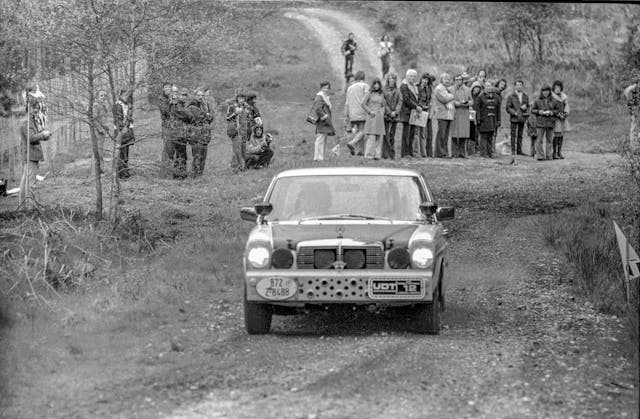
It was to be 10 years before Stirling Moss would find himself in the Sahara desert. There had been a long gap in Stirling Moss’ rally career when racing friend Michael “Mickey” Taylor suggested they tackle the forthcoming UDT World Cup Rally 1974. Taylor had competed on the London-Sydney Marathon in 1968, and with their Mercedes-Benz connections they thought they could get a decent car. The die was cast, and with mechanic Allan Sell as the third team member, they entered a Stuttgart prepared Mercedes Benz 280E.
The rally was to take entrants from Wembley, London, across the Sahara to Nigeria, then back north to Europe, circuit Turkey, and finish at Munich for the FIFA World Cup Football Finals. A similar format had been successful with the 1970 London-Mexico World Cup Rally, which finished a few days before the FIFA Finals of that year.
Moss and his team started 12th and kicked off with two short stages in the U.K. so as to attract the press’ attention. From the start Moss was adopting a foot-to-floor attitude, even unloading the boot of the car and siphoning off as much fuel as he dared so as to maximize his advantage. But already the car was bottoming out, and Taylor was trying to limit Moss’ enthusiasm—this was an endurance rally, and a tortoise was likely to win rather than a hare. By the time the cavalcade of cars reached Southampton, Moss was lying 12th of 58 starters.
A series of stages in Spain saw more issues, and it was surprising they were not better prepared. The jack didn’t work, Moss was having problems heel and toeing (although Sell found an old shoe and wired it to the accelerator, which seemed to work), the light of the compass was missing (essential for Sahara travel), there were more suspension issues, and other niggles reared their head that ought to have been sorted out before the start.
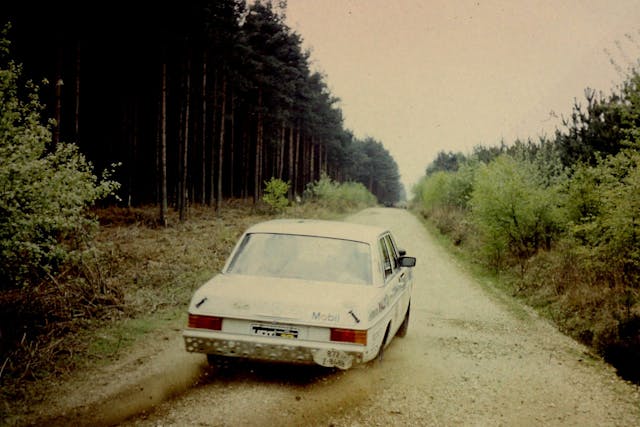
The rally departed Tangier to face two crossings of the Sahara, and by the time the Moss team had crossed the Atlas Mountains their rally was effectively over. Moss had crashed the car into a washaway and broken the chassis, and to make matters worse the oil was gone from the gearbox. But Sell earned his crust and he kept them going. Then they had to stop overnight after getting lost in sand dunes and waited for daylight to find their way out.
Sell was working overtime to keep the car rolling, and they decided to avoid the loop into Nigeria and remain in Tamanrasset for R&R while working on the car. The Mercedes was one of several walking-wounded crews struggling along, and yet still they all faced the tough trip north to Tunisia.
Restarting from Tamanrasset to head towards Tunisia, Moss persisted in pressing on despite the state of the car and was soon overtaking rivals, but once again the car couldn’t take the punishment it was getting. It suffered more punctures, the dashboard had fallen out, the shocks had to be changed, and Sell was utterly exhausted. So it was that they arrived at an abandoned Foreign Legion fort and decided to await rescue.
Why did they stop? Unconfirmed reports are that Moss dispensed with their reserves of water at Tamanrasset to lessen the weight in the car. So with little shade and virtually no drinking water, all they would have left was the water in the old well and the remains of anything left in the radiator. They were also one of the last cars in the convoy, however a Brazilian entry offered to take a message to the next control, 800 kilometers away, requesting rescue. The three limited themselves to three cups of water each a day and sat in the eerie desert silence awaiting their fate.
Back at Tamanrasset, there had been no plans for a sweeper car to travel along behind the rally, but at the behest of Andrew Cowan, who was concerned about the condition of some of the cars and crews, organizer Jim Gavin was persuaded to find a couple of vehicles and follow the rally north. Having sourced a couple of Land Rovers, he set off.
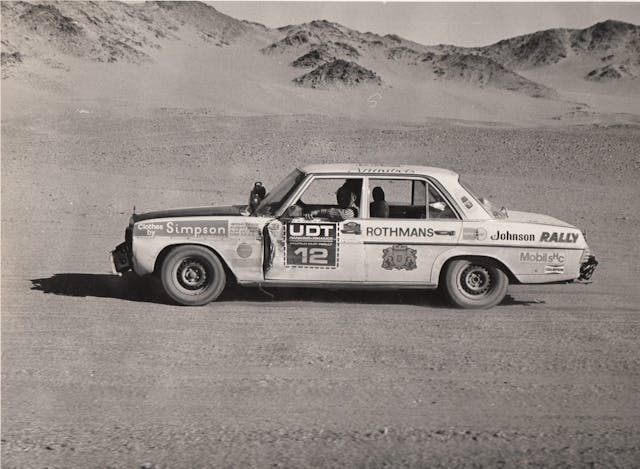
At the fort no plane flew by, no other vehicles came by, and the crew of no. 12 had a long, lonely night. Still there was no rescue. Moss said later that he feared they would soon die of dehydration, probably not a pleasant experience.
They waited the next day, becoming particularly concerned about Sell, who was in a poor state. Eventually, and thankfully for all three, Gavin drove by and was able to provide succor. The rescuers provided food and drink, medical help to Sell, and helped get the car rolling again. They then sent them ahead with the Land Rovers following.
It’s not difficult to imagine the headlines back in London had things turned less favorable. After all, anyone around in 1982 can’t fail to remember the media frenzy when Mark Thatcher, son of the U.K. Prime Minister, became lost in the desert on the Dakar Rally.
It would be 15 years before Stirling Moss was tempted back into a rally car, this time on the Classic Rally Association (CRA) Alpine Rallies, reruns of those he had been so successful in before, but now for historic rally cars. Needless to say Moss had lost none of his expertise and competed four times, three times in MGBs, getting top results but finishing last in an Austin Healey 3000 after crashing it twice.
After buying a Ford Shelby Mustang GT350 for historic racing, he took part in the inaugural Targa Tasmania in 1992, a closed road rally around the Australian island state. After a major crash on the recon run prior to the rally, two local residents were seriously injured and Moss was prosecuted by the police. The furor that followed among some sections of the public nearly brought about the cancellation of the event, but it eventually went ahead, with Moss being told to keep a low profile. He finished 20th.
Following the Sahara incident, Moss and Gavin became good friends, and when Gavin introduced him to lawnmower racing he was to be seen racing around the fields of West Sussex. Moss also did a 12-hour lawnmower race partnered with Derek Bell, a one-time Le Mans winner.
However, it was the end of the legend’s rally life. He rallied with the best and was a match for any of them. A remarkable driver, whatever the car, circuit, or rally road.
“Stirling Moss – Rally Driver,” by Vic Quayle, is published in hardback with about 150 images, maps, results, and more by herridgeandsons.com. It is priced $42 on Amazon.
Via Hagerty UK
